airbag CHEVROLET TRAVERSE 2009 1.G Owners Manual
[x] Cancel search | Manufacturer: CHEVROLET, Model Year: 2009, Model line: TRAVERSE, Model: CHEVROLET TRAVERSE 2009 1.GPages: 422, PDF Size: 2.06 MB
Page 1 of 422

Seats and Restraint
System............................... 1-1
Head Restraints
.............. 1-2
Front Seats
.................... 1-3
Rear Seats
.................... 1-9
Safety Belts
..................1-14
Child Restraints
.............1-27
Airbag System
..............1-46
Restraint System
Check
......................1-59
Features and Controls...... 2-1
Keys
............................. 2-2
Doors and Locks
............ 2-8
Windows
......................2-14
Theft-Deterrent
Systems
...................2-16
Starting and Operating
Your Vehicle
.............2-20
Mirrors
.........................2-31
Object Detection
Systems
...................2-36
OnStar
®System
............2-43Universal Home Remote
System
.....................2-47
Storage Areas
...............2-52
Sunroof
........................2-56
Instrument Panel............... 3-1
Instrument Panel
Overview
.................... 3-4
Climate Controls
............3-19
Warning Lights, Gages,
and Indicators
............3-30
Driver Information
Center (DIC)
.............3-44
Audio System(s)
............3-73
Driving Your Vehicle......... 4-1
Your Driving, the Road,
and the Vehicle
........... 4-1
Towing
........................4-21
Service and
Appearance Care............... 5-1
Service
.......................... 5-3
Fuel
.............................. 5-5
Checking Things Under
the Hood
.................... 5-9Headlamp Aiming
..........5-33
Bulb Replacement
.........5-33
Windshield Wiper Blade
Replacement
.............5-35
Tires
...........................5-36
Appearance Care
..........5-78
Vehicle Identi�cation
......5-85
Electrical System
...........5-85
Capacities and
Speci�cations
............5-92
Maintenance Schedule...... 6-1
Maintenance Schedule
..... 6-1
Customer Assistance
Information........................ 7-1
Customer Assistance and
Information
................. 7-1
Reporting Safety
Defects
.....................7-14
Vehicle Data Recording
and Privacy
...............7-16
Index....................................i-1
2009 Chevrolet Traverse Owner ManualM
Page 4 of 422
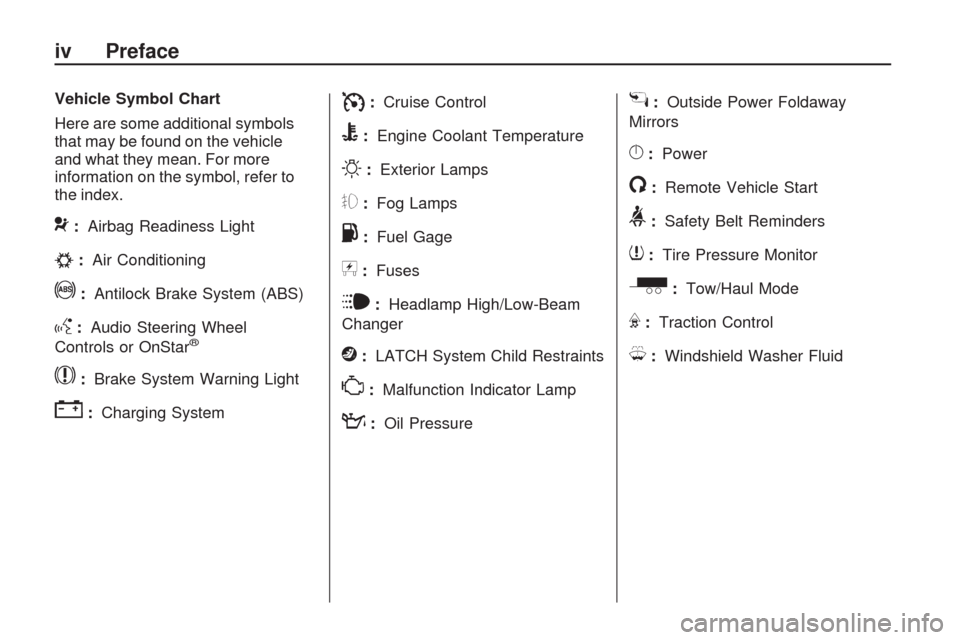
Vehicle Symbol Chart
Here are some additional symbols
that may be found on the vehicle
and what they mean. For more
information on the symbol, refer to
the index.
9:Airbag Readiness Light
#:Air Conditioning
!:Antilock Brake System (ABS)
g:Audio Steering Wheel
Controls or OnStar®
$:Brake System Warning Light
":Charging System
I:Cruise Control
B:Engine Coolant Temperature
O:Exterior Lamps
#:Fog Lamps
.:Fuel Gage
+:Fuses
i:Headlamp High/Low-Beam
Changer
j:LATCH System Child Restraints
*:Malfunction Indicator Lamp
::Oil Pressure
g:Outside Power Foldaway
Mirrors
}:Power
/:Remote Vehicle Start
>:Safety Belt Reminders
7:Tire Pressure Monitor
_:Tow/Haul Mode
F:Traction Control
M:Windshield Washer Fluid
iv Preface
Page 5 of 422
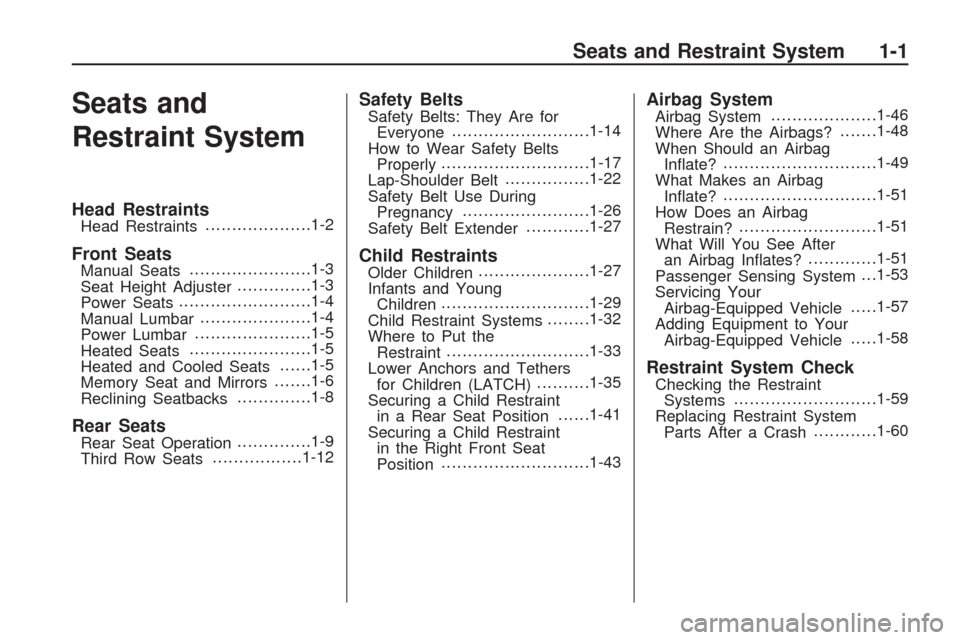
Seats and
Restraint System
Head RestraintsHead Restraints....................1-2
Front SeatsManual Seats.......................1-3
Seat Height Adjuster..............1-3
Power Seats.........................1-4
Manual Lumbar.....................1-4
Power Lumbar......................1-5
Heated Seats.......................1-5
Heated and Cooled Seats......1-5
Memory Seat and Mirrors.......1-6
Reclining Seatbacks..............1-8
Rear SeatsRear Seat Operation..............1-9
Third Row Seats.................1-12
Safety BeltsSafety Belts: They Are for
Everyone..........................1-14
How to Wear Safety Belts
Properly............................1-17
Lap-Shoulder Belt................1-22
Safety Belt Use During
Pregnancy........................1-26
Safety Belt Extender............1-27
Child RestraintsOlder Children.....................1-27
Infants and Young
Children............................1-29
Child Restraint Systems........1-32
Where to Put the
Restraint...........................1-33
Lower Anchors and Tethers
for Children (LATCH)..........1-35
Securing a Child Restraint
in a Rear Seat Position......1-41
Securing a Child Restraint
in the Right Front Seat
Position............................1-43
Airbag SystemAirbag System....................1-46
Where Are the Airbags?.......1-48
When Should an Airbag
In�ate?.............................1-49
What Makes an Airbag
In�ate?.............................1-51
How Does an Airbag
Restrain?..........................1-51
What Will You See After
an Airbag In�ates?.............1-51
Passenger Sensing System. . .1-53
Servicing Your
Airbag-Equipped Vehicle.....1-57
Adding Equipment to Your
Airbag-Equipped Vehicle.....1-58
Restraint System CheckChecking the Restraint
Systems...........................1-59
Replacing Restraint System
Parts After a Crash............1-60
Seats and Restraint System 1-1
Page 21 of 422
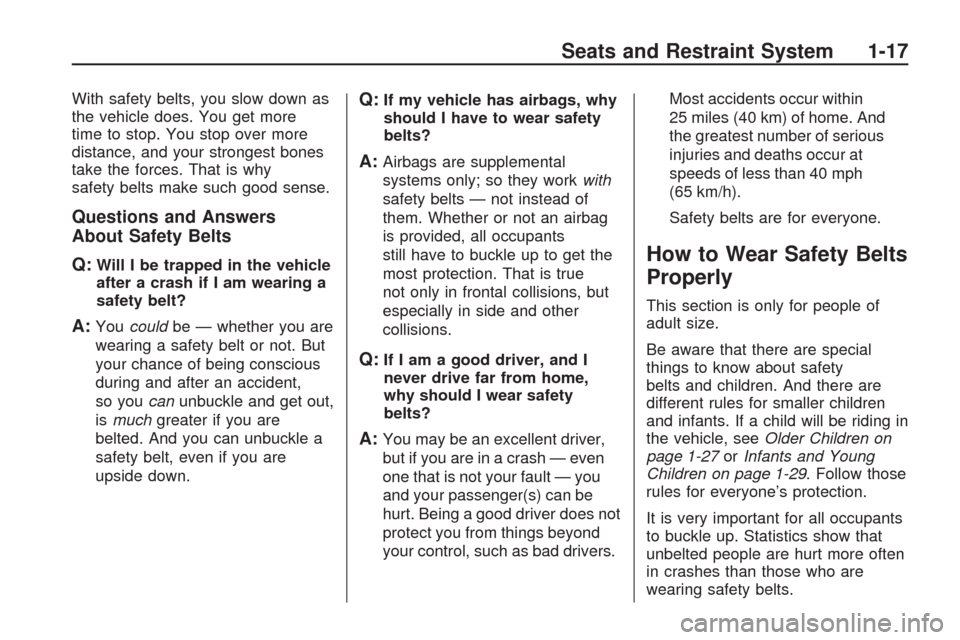
With safety belts, you slow down as
the vehicle does. You get more
time to stop. You stop over more
distance, and your strongest bones
take the forces. That is why
safety belts make such good sense.
Questions and Answers
About Safety Belts
Q:
Will I be trapped in the vehicle
after a crash if I am wearing a
safety belt?
A:Youcouldbe — whether you are
wearing a safety belt or not. But
your chance of being conscious
during and after an accident,
so youcanunbuckle and get out,
ismuchgreater if you are
belted. And you can unbuckle a
safety belt, even if you are
upside down.
Q:If my vehicle has airbags, why
should I have to wear safety
belts?
A:Airbags are supplemental
systems only; so they workwith
safety belts — not instead of
them. Whether or not an airbag
is provided, all occupants
still have to buckle up to get the
most protection. That is true
not only in frontal collisions, but
especially in side and other
collisions.
Q:If I am a good driver, and I
never drive far from home,
why should I wear safety
belts?
A:You may be an excellent driver,
but if you are in a crash — even
one that is not your fault — you
and your passenger(s) can be
hurt. Being a good driver does not
protect you from things beyond
your control, such as bad drivers.Most accidents occur within
25 miles (40 km) of home. And
the greatest number of serious
injuries and deaths occur at
speeds of less than 40 mph
(65 km/h).
Safety belts are for everyone.
How to Wear Safety Belts
Properly
This section is only for people of
adult size.
Be aware that there are special
things to know about safety
belts and children. And there are
different rules for smaller children
and infants. If a child will be riding in
the vehicle, seeOlder Children on
page 1-27orInfants and Young
Children on page 1-29. Follow those
rules for everyone’s protection.
It is very important for all occupants
to buckle up. Statistics show that
unbelted people are hurt more often
in crashes than those who are
wearing safety belts.
Seats and Restraint System 1-17
Page 28 of 422
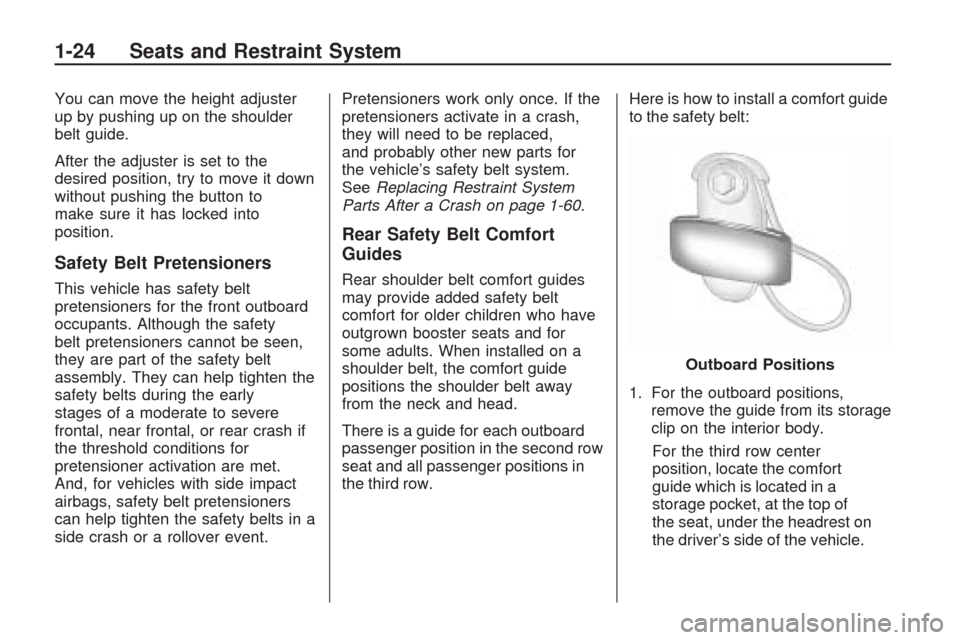
You can move the height adjuster
up by pushing up on the shoulder
belt guide.
After the adjuster is set to the
desired position, try to move it down
without pushing the button to
make sure it has locked into
position.
Safety Belt Pretensioners
This vehicle has safety belt
pretensioners for the front outboard
occupants. Although the safety
belt pretensioners cannot be seen,
they are part of the safety belt
assembly. They can help tighten the
safety belts during the early
stages of a moderate to severe
frontal, near frontal, or rear crash if
the threshold conditions for
pretensioner activation are met.
And, for vehicles with side impact
airbags, safety belt pretensioners
can help tighten the safety belts in a
side crash or a rollover event.Pretensioners work only once. If the
pretensioners activate in a crash,
they will need to be replaced,
and probably other new parts for
the vehicle’s safety belt system.
SeeReplacing Restraint System
Parts After a Crash on page 1-60.
Rear Safety Belt Comfort
Guides
Rear shoulder belt comfort guides
may provide added safety belt
comfort for older children who have
outgrown booster seats and for
some adults. When installed on a
shoulder belt, the comfort guide
positions the shoulder belt away
from the neck and head.
There is a guide for each outboard
passenger position in the second row
seat and all passenger positions in
the third row.Here is how to install a comfort guide
to the safety belt:
1. For the outboard positions,
remove the guide from its storage
clip on the interior body.
For the third row center
position, locate the comfort
guide which is located in a
storage pocket, at the top of
the seat, under the headrest on
the driver’s side of the vehicle.Outboard Positions
1-24 Seats and Restraint System
Page 33 of 422

{CAUTION
Never do this.
Never allow a child to wear the
safety belt with the shoulder belt
behind their back. A child can be
seriously injured by not wearing
the lap-shoulder belt properly. In a
crash, the child would not be
restrained by the shoulder belt.
The child could move too far
forward increasing the chance of
head and neck injury. The child
might also slide under the lap
belt. The belt force would then be
applied right on the abdomen.
That could cause serious or fatal
injuries. The shoulder belt should
go over the shoulder and across
the chest.
Infants and Young
Children
Everyone in a vehicle needs
protection! This includes infants and
all other children. Neither the
distance traveled nor the age and
size of the traveler changes the
need, for everyone, to use safety
restraints. In fact, the law in
every state in the United States and
in every Canadian province says
children up to some age must
be restrained while in a vehicle.
{CAUTION
Children can be seriously injured
or strangled if a shoulder belt is
wrapped around their neck and
the safety belt continues to
tighten. Never leave children
unattended in a vehicle and never
allow children to play with the
safety belts.
Airbags plus lap-shoulder belts offer
protection for adults and older
children, but not for young children
and infants. Neither the vehicle’s
safety belt system nor its airbag
system is designed for them. Every
time infants and young children
ride in vehicles, they should have
the protection provided by
appropriate child restraints.
Children who are not restrained
properly can strike other people, or
can be thrown out of the vehicle.
Seats and Restraint System 1-29
Page 34 of 422
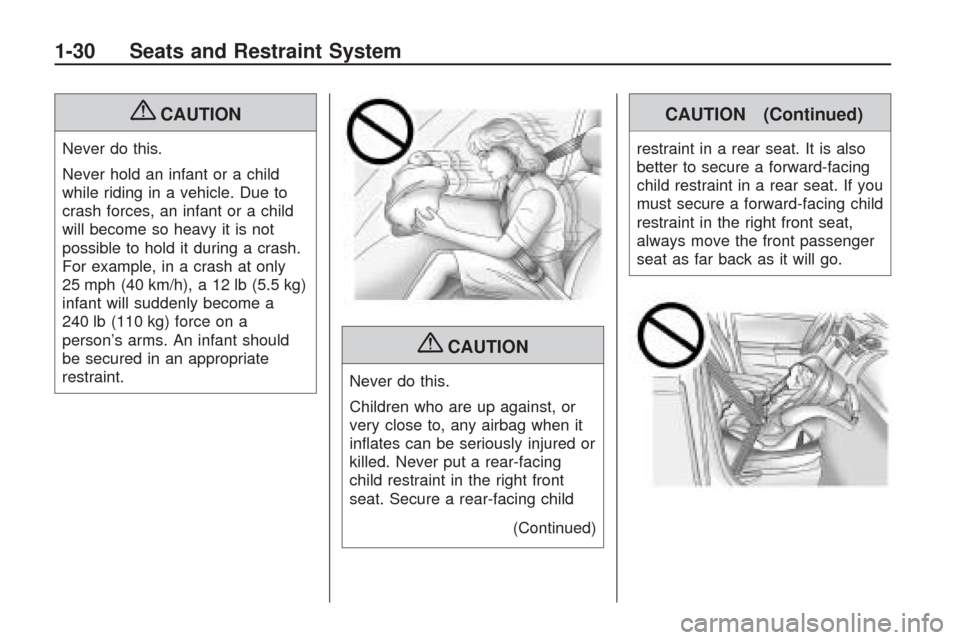
{CAUTION
Never do this.
Never hold an infant or a child
while riding in a vehicle. Due to
crash forces, an infant or a child
will become so heavy it is not
possible to hold it during a crash.
For example, in a crash at only
25 mph (40 km/h), a 12 lb (5.5 kg)
infant will suddenly become a
240 lb (110 kg) force on a
person’s arms. An infant should
be secured in an appropriate
restraint.
{CAUTION
Never do this.
Children who are up against, or
very close to, any airbag when it
in�ates can be seriously injured or
killed. Never put a rear-facing
child restraint in the right front
seat. Secure a rear-facing child
(Continued)
CAUTION (Continued)
restraint in a rear seat. It is also
better to secure a forward-facing
child restraint in a rear seat. If you
must secure a forward-facing child
restraint in the right front seat,
always move the front passenger
seat as far back as it will go.
1-30 Seats and Restraint System
Page 38 of 422

A label on the sun visor says,
“Never put a rear-facing child
restraint in the front.” This is
because the risk to the rear-facing
child is so great, if the airbag
deploys.
{CAUTION
A child in a rear-facing child
restraint can be seriously injured
or killed if the right front
passenger airbag in�ates. This is
because the back of the
rear-facing child restraint would
be very close to the in�ating
airbag. A child in a forward-facing
child restraint can be seriously
injured or killed if the right front
passenger airbag in�ates and the
passenger seat is in a forward
position.
(Continued)
CAUTION (Continued)
Even if the passenger sensing
system has turned off the right
front passenger frontal airbag, no
system is fail-safe. No one can
guarantee that an airbag will not
deploy under some unusual
circumstance, even though it is
turned off.
Secure rear-facing child restraints
in a rear seat, even if the airbag is
off. If you secure a forward-facing
child restraint in the right front seat,
always move the front passenger
seat as far back as it will go. It is
better to secure the child restraint
in a rear seat.
SeePassenger Sensing System
on page 1-53for additional
information.When securing a child restraint in a
rear seating position, study the
instructions that came with the child
restraint to make sure it is
compatible with this vehicle.
Wherever a child restraint is
installed, be sure to secure the child
restraint properly.
Keep in mind that an unsecured
child restraint can move around
in a collision or sudden stop
and injure people in the vehicle.
Be sure to properly secure any child
restraint in the vehicle — even
when no child is in it.
1-34 Seats and Restraint System
Page 47 of 422
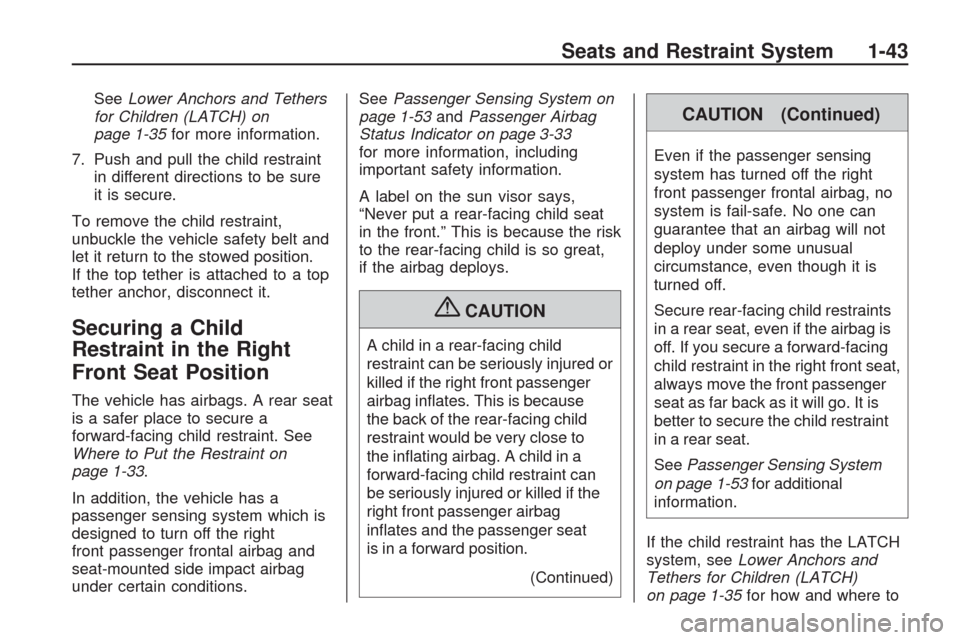
SeeLower Anchors and Tethers
for Children (LATCH) on
page 1-35for more information.
7. Push and pull the child restraint
in different directions to be sure
it is secure.
To remove the child restraint,
unbuckle the vehicle safety belt and
let it return to the stowed position.
If the top tether is attached to a top
tether anchor, disconnect it.
Securing a Child
Restraint in the Right
Front Seat Position
The vehicle has airbags. A rear seat
is a safer place to secure a
forward-facing child restraint. See
Where to Put the Restraint on
page 1-33.
In addition, the vehicle has a
passenger sensing system which is
designed to turn off the right
front passenger frontal airbag and
seat-mounted side impact airbag
under certain conditions.SeePassenger Sensing System on
page 1-53andPassenger Airbag
Status Indicator on page 3-33
for more information, including
important safety information.
A label on the sun visor says,
“Never put a rear-facing child seat
in the front.” This is because the risk
to the rear-facing child is so great,
if the airbag deploys.
{CAUTION
A child in a rear-facing child
restraint can be seriously injured or
killed if the right front passenger
airbag in�ates. This is because
the back of the rear-facing child
restraint would be very close to
the in�ating airbag. A child in a
forward-facing child restraint can
be seriously injured or killed if the
right front passenger airbag
in�ates and the passenger seat
is in a forward position.
(Continued)
CAUTION (Continued)
Even if the passenger sensing
system has turned off the right
front passenger frontal airbag, no
system is fail-safe. No one can
guarantee that an airbag will not
deploy under some unusual
circumstance, even though it is
turned off.
Secure rear-facing child restraints
in a rear seat, even if the airbag is
off. If you secure a forward-facing
child restraint in the right front seat,
always move the front passenger
seat as far back as it will go. It is
better to secure the child restraint
in a rear seat.
SeePassenger Sensing System
on page 1-53for additional
information.
If the child restraint has the LATCH
system, seeLower Anchors and
Tethers for Children (LATCH)
on page 1-35for how and where to
Seats and Restraint System 1-43
Page 48 of 422

install the child restraint using
LATCH. If a child restraint is secured
using a safety belt and it uses a
top tether, seeLower Anchors and
Tethers for Children (LATCH)
on page 1-35for top tether anchor
locations.
Do not secure a child seat in a
position without a top tether anchor
if a national or local law requires
that the top tether be anchored, or if
the instructions that come with
the child restraint say that the top
strap must be anchored.
In Canada, the law requires that
forward-facing child restraints have
a top tether, and that the tether
be attached.
You will be using the lap-shoulder
belt to secure the child restraint in
this position. Follow the instructions
that came with the child restraint.
1. Move the seat as far back as it
will go before securing the
forward-facing child restraint.When the passenger sensing
system has turned off the
right front passenger frontal
airbag and seat-mounted side
impact airbag, the off indicator on
the passenger airbag status
indicator should light and stay lit
when the vehicle is started.
SeePassenger Airbag Status
Indicator on page 3-33.
2. Put the child restraint on
the seat.
3. Pick up the latch plate, and
run the lap and shoulder portions
of the vehicle’s safety belt
through or around the restraint.
The child restraint instructions
will show you how.4. Push the latch plate into the
buckle until it clicks.
Position the release button on
the buckle so that the safety belt
could be quickly unbuckled if
necessary.
1-44 Seats and Restraint System